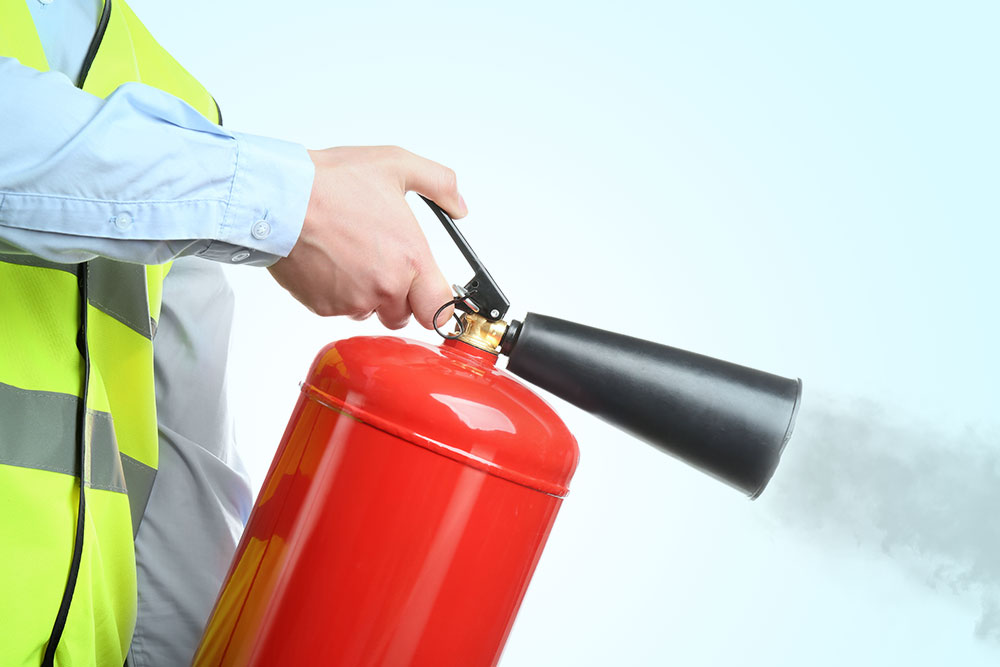
Most of us like to think we’d do the right thing in a fire emergency, like reaching for an extinguisher at the right time. Statistics don’t suggest this is true, however. In 2020, extinguishers were only used in around 7% of fires attended by emergency services. This figure might sound shockingly low, but it’s probably around the level it should be because not everyone should use a fire extinguisher in an emergency at work. Read our guide to understand your workplace fire safety duties and learn who is responsible for using a fire extinguisher when disaster strikes.
Fire Safety at Work
Everyone has a role to play in workplace fire safety. Still, in every workplace or non-domestic property, one (or more) person will ultimately be responsible for fire safety. They’re known as the responsible person (or persons when there’s more than one).
Their choices will decide who’s responsible for using fire extinguishers, among other critical fire safety measures.
Responsible Persons
Fire safety generally starts at the top of an organisation. Responsible persons are usually employers, landlords or building managers and they have several duties relating to fire safety in the workplace, including:
- Conducting and reviewing fire risk assessments
- Sharing risk assessment findings with staff or other occupants
- Ensuring adequate firefighting equipment is present in the workplace
- Establishing and maintaining appropriate fire safety measures
- Planning for emergencies, including evacuations
- Providing staff with adequate fire safety information and training
It’s unrealistic to expect one or even multiple people to complete all of the above. Especially since effective fire safety requires constant vigilance and revision.
Therefore, responsible persons are legally allowed to entrust specific duties to other competent individuals as long as they’re sure that individual has the knowledge, skills and experience to do the job safely.
For example, an employer might appoint a fire safety expert to complete the fire risk assessment. In this case, the responsible person still fulfils their risk assessment duties even if they’re not doing the work themselves.
Responsible persons will also enlist fire wardens to assist them in their fire safety duties.
Fire Wardens
Fire wardens (also sometimes referred to as fire marshals) are given additional fire safety duties by the responsible person. One of these may be using firefighting equipment, such as fire extinguishers, to halt the spread of a fire if it’s safe. Other duties include:
- Testing fire alarms
- Inspecting firefighting equipment, including extinguishers
- Supporting the implementation of fire risk control measures
- Offering assistance during evacuations
(This fire warden duties infographic can be shared with your team)
Fire Wardens must be provided additional training by the responsible person to ensure they can safely fulfil these expanded fire safety duties.
Everyone Else
Unless you’ve been given additional duties by the responsible person, you must follow your organisation’s fire safety policies.
You should be given all the training you need to do this. And it shouldn’t require much more than participating in regular fire drills, completing visual user checks before using electrical equipment and knowing how to raise the alarm if you notice something’s wrong.
You are not expected to use fire extinguishers unless instructed to do so and given adequate training.

Fire Extinguisher Training
To safely use a fire extinguisher and make a difference in the firefighting efforts, you need to know what you’re doing.
That’s why only certain employees are chosen for firefighting duties and given the additional training to handle fire extinguishers. It’s critical to understand classes of fire and know the corresponding extinguisher type to tackle them. Various extinguishers also require different techniques to work effectively. All of this vital knowledge should be covered in fire extinguisher training.
But even with training, you should be cautious when fighting a fire with an extinguisher. You must only use an extinguisher if:
- You’ve been trained to do so
- The fire alarm has been raised
- The fire is small
- There is a clear exit route
- You’re confident you can put out the fire safely
If any of the above conditions aren’t met, you should prioritise evacuation over firefighting.
Safe Evacuation
There are rare situations, though, where it’s appropriate for anyone to use an extinguisher – training or no training.
Untrained individuals should only use a fire extinguisher if it’s necessary in order to safely evacuate. In some emergencies, the only exit routes can become blocked by fire and using an extinguisher to clear a path is the only option left to safely escape.
If you’re ever in a similar situation, you should be reaching for the nearest fire extinguisher. But your intention should be to clear a safe path for escape, not actually attempt to extinguish the fire.
You can think of it as first-aid firefighting equipment. First aid is used to stabilise a patient before emergency services can arrive and take over. This is similar to the intended use of fire extinguishers – they’re tools you might need to use to evacuate safely before emergency responders can arrive and actually put out the fire.
Where Can I Learn How to Use a Fire Extinguisher?
Using a fire extinguisher without instruction puts yourself and others at risk and can worsen a bad situation. You need training to be prepared to use one in a fire emergency.
Our online Fire Extinguisher Course teaches you to safely handle a fire extinguisher in an emergency. You’ll learn about the different types of fire and the corresponding extinguishers to use. In the event of a fire, you can choose the suitable extinguisher, handle it correctly and give yourself and your colleagues the best chance to evacuate safely.




















































































































































































































































































































































































































































































































































































































































































































































